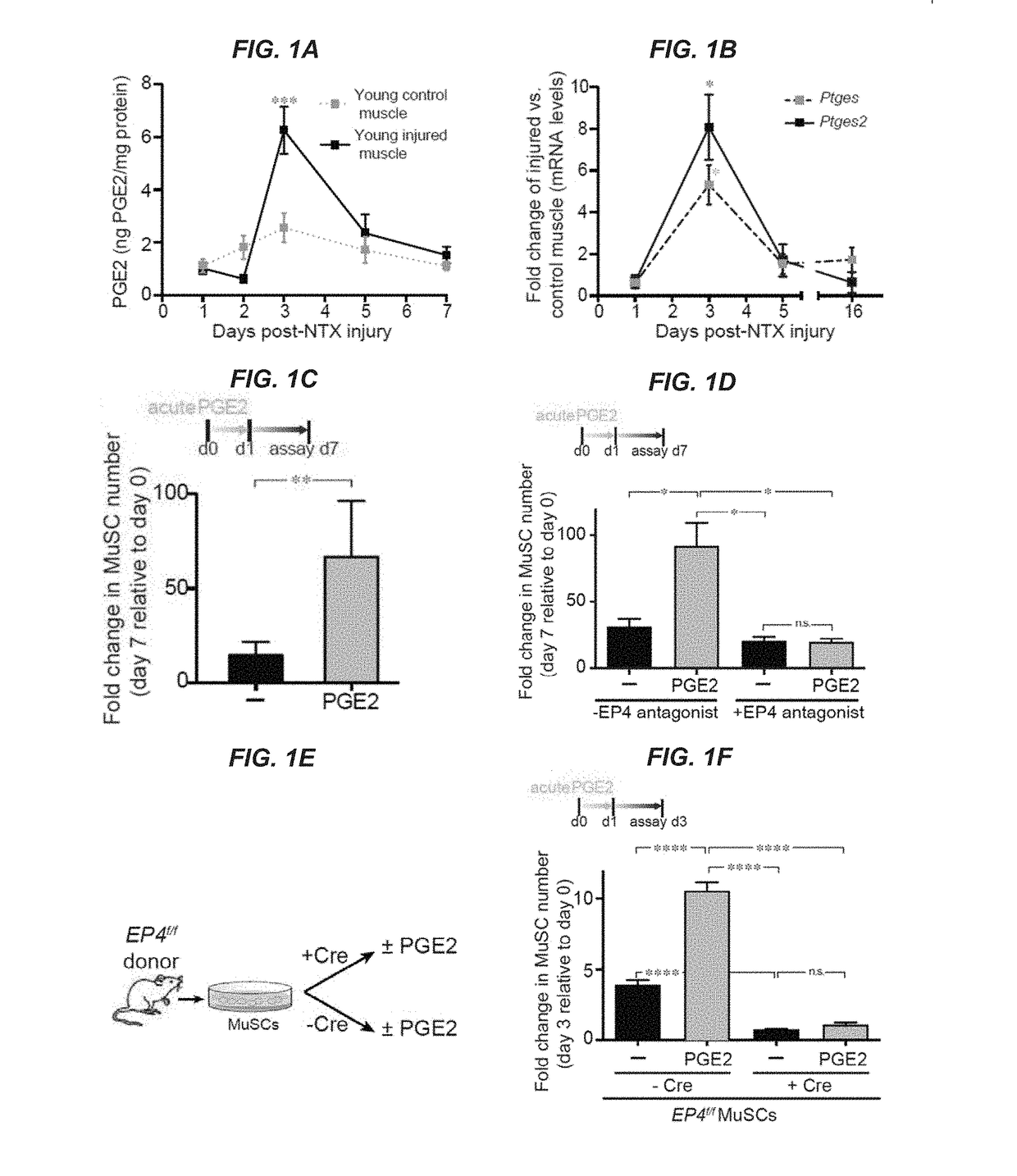Compositions and Methods for Muscle Regeneration Using Prostaglandin E2
a technology of prostaglandin and muscle, applied in the direction of drug composition, skeletal/connective tissue cells, cardiovascular disorders, etc., can solve the problems of muscle mass loss, strength and function impairment, and impaired quality of life in the ever-increasing aged population, and achieve the effect of enhancing muscle function and increasing the population of muscle cells
- Summary
- Abstract
- Description
- Claims
- Application Information
AI Technical Summary
Benefits of technology
Problems solved by technology
Method used
Image
Examples
example 1
staglandin E2 Delivery Augments Skeletal Muscle Regeneration and Strength in Aged Mice
[0137]This example illustrates that PGE2 signaling is required for muscle stem cell function during regeneration.
[0138]The elderly suffer from progressive skeletal muscle wasting and regenerative failure that decreases mobility and quality of life1,2. Crucial to muscle regeneration are adult muscle stem cells (MuSCs) that reside in niches in muscle tissues, poised to respond to damage and repair skeletal muscles throughout life3-8. During aging, the proportion of functional MuSCs markedly decreases, hindering muscle regeneration9-13. To date, no therapeutic agents are in clinical use that target MuSCs to combat this regenerative decline. Here, we identify a natural immunomodulator, prostaglandin E2 (PGE2), as a potent regulator of MuSC function essential to muscle regeneration. We found that the PGE2 receptor, EP4, is essential for MuSC proliferation in vitro and engraftment in vivo in mice. In MuS...
example 2
Muscle Forces after Prostaglandin E2 (PGE2) Injection
[0231]This example shows an increase in specific twitch force of gastrocnemius muscles in aged mice injected with PGE2. The aged mice (18 months old) were subject to treadmill run to exhaustion daily for 10 days. The treadmill run was performed using the Exer3 / 6 (Columbus Instruments). Mice ran on the treadmill at 20 degrees downhill, starting at a speed of 10 meters / min. After 3 min, the speed was increased 1 meter / min to a final speed of 20 meters / min. Exhaustion was defined as the inability of the animal to remain on the treadmill despite electrical prodding. 2 h after each treadmill run, both gastrocnemius muscles of each mouse were injected with either PBS (control group) or 3 nM PGE2 (experimental group). The force measurement was performed 4 weeks after the last treadmill run using a 300C-LR force transducer (Aurora Scientific) with a single 0.1 ms pulse at predetermined supramaximal stimulation intensity.
[0232]Representati...
embodiment 1
2. The method of embodiment 1, wherein the population of isolated muscle cells is purified.
3. The method of embodiment 1 or 2, wherein the population of isolated muscle cells comprises skeletal muscle cells, smooth muscle cells, cardiac muscle cells, embryonic stem cell-derived muscle cells, induced pluripotent stem cell-derived muscle cells, dedifferentiated muscle cells, or a combination thereof.
4. The method of any one of embodiments 1 to 3, wherein the population of isolated muscle cells comprises muscle stem cells, satellite cells, myocytes, myoblasts, myotubes, myofibers, or a combination thereof.
5. The method of any one of embodiments 1 to 4, wherein the population of isolated muscle cells is obtained from a subject.
PUM
| Property | Measurement | Unit |
|---|---|---|
| time- | aaaaa | aaaaa |
| concentrations | aaaaa | aaaaa |
| time- | aaaaa | aaaaa |
Abstract
Description
Claims
Application Information
 Login to View More
Login to View More - R&D
- Intellectual Property
- Life Sciences
- Materials
- Tech Scout
- Unparalleled Data Quality
- Higher Quality Content
- 60% Fewer Hallucinations
Browse by: Latest US Patents, China's latest patents, Technical Efficacy Thesaurus, Application Domain, Technology Topic, Popular Technical Reports.
© 2025 PatSnap. All rights reserved.Legal|Privacy policy|Modern Slavery Act Transparency Statement|Sitemap|About US| Contact US: help@patsnap.com



